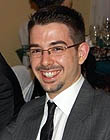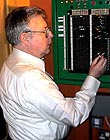|
|
This topic comprises 3 pages: 1 2 3
|
|
Author
|
Topic: "We Ran It Wet"
|
|
|
|
|
|
|
Jack Ondracek
Film God

Posts: 2348
From: Port Orchard, WA, USA
Registered: Oct 2002
|
 posted 02-22-2003 07:14 PM
posted 02-22-2003 07:14 PM





Just speculating here...
but, when I was working in TV (back in the early '70s), the newsguys would take the processed film, edit it (except for 'B' rolls, which we had to do), separate the cuts with leader film & send it in on one reel. We'd run the film through a comb filter & put the cuts, with the standard countdown we used, on tape (um.... dating me here... 2" quad!) in the order it was expected to run in the evening news.
Perhaps the saying refers to a less edited process where the film might be run directly 'on air'...?? It would be a way to get something on quickly, though without the pomp & procedure of normal operations.
We were running color, super 8 mm magstripe, though the other stations were running 16mm... B&W! ![[evil]](graemlins/evil.gif)
It was the first time I'd ever seen film get stored in a refrigerator!
| IP: Logged
|
|
Bill Carter
Expert Film Handler

Posts: 162
From: Minneapolis, Minnesota
Registered: Sep 1999
|
 posted 02-22-2003 10:44 PM
posted 02-22-2003 10:44 PM




I've known of 16mm newsfilm literally being run wet. Remember that most stations had their own 16mm reversal processing in-house. For a late-breaking story, you could pull the film out right after the wash, skipping the forced air drying compartment of the processing machine. You might try to wipe some of the water off with a cloth as it wound onto the reel, if you had time. The film could be aired on the telecine while literally wet, if it meant the difference in getting the story on the air or not.
I've also heard of something even stranger...
In the B&W days, reversal film could be threaded through some processors (like the old Houston-Fearless) so as to skip the second developer steps and go right into the fixer, and pulled out of the machine as a NEGATIVE (with really wacky gamma). You then flipped the polarity switch on the film chain camera, which switched the camera to a negative image, and aired it that way. It was ugly, but it was considered better than letting a competing station get the pictures on the air first. You could get film on the air in about half the normal time that way.But that one was only done in extreme situations, where time was of the absolute essence, and where additional footage could be shot of the same scene for later air. That was necessary because the incompletely processed image would start fading away almost as soon as it came out of the machine.
| IP: Logged
|
|
|
|
|
|
Stephen Furley
Film God

Posts: 3059
From: Coulsdon, Croydon, England
Registered: May 2002
|
 posted 02-23-2003 06:38 AM
posted 02-23-2003 06:38 AM




Eastman VNF is still made, but I'm not sure what it's used for now, obviously not news work.
John?
It used to be horrible stuff, I haven't seen any for years; I don't know if it's improved since then.
Returning to the original subject, the Baird intermediate film system, used briefly by the BBC in 1936 transmitted wet film, I think it was 17.5mm, but I've never seen any. There are supposed to be a few frames surviving somewhere.
The film passed straight from the camera to a processor, where it was processed in less than a minute, and was then transmitted wet. A cyanide fixer was used, I assume this was for speed, and I think the film must have been a negative. I once met someone who had worked on this equipment, and he said that performers would sometimes rush to the control room when they finished their act, to catch the last few seconds of their performance on the monitor.
I think the Baird system, in its final version, achieved something like 240 lines. The BBC used this, and the Marconi EMI 405 line system alternately for a short time, then the decision was made that the Marconi system would be adopted, and Baird was dropped. The Marconi system was used until the television service was shut down on the outbreak of war in 1939.
The same system was used when the service resumed after the war, and a second, independant, channel started in the '50s. The BBC made some expermental colour transmissions, using NTSC on 405 lines, but it was decided that Britain would switch to the european standard CCIR 625 line system. This was first used here when our third channel, BBC2, started in 1964, (and was put off the air on it's opening night by a fire in a power station).
The two existing channels remained on 405 lines VHF (the 625 lines service is on UHF), so dual-standard sets were made for some years; we didn't have one of these, so we couldn't get BBC2; I remember being jealous of the neighbours and their new 625 line set!
Regular colour transmissions started in 1967, using PAL, and from this time, the other two channels were also available on 625 lines UHF, but also continued, in black and white, on 405 lines, VHF. The last VHF transmittrs were not shut down until the early '80s, by which time the last 405 only sets would have been getting on for twenty years old. I doubt if there were many still in use for several years before this.
It's a pity that more of the early television equipment doesn't survive.
| IP: Logged
|
|
|
|
Stephen Furley
Film God

Posts: 3059
From: Coulsdon, Croydon, England
Registered: May 2002
|
 posted 02-23-2003 08:04 AM
posted 02-23-2003 08:04 AM




Paul,
the Baird system must have been an absolute nightmare to work with. From pictures I've seen, it looks like the camera was fixed in position, built into the studio wall. I don't think multi-camera work would have been possible, and I'm not sure how much film stock the camera could hold.
As I understand it, an anouncer would be standing in darkness, in the flying spot 'spotlight studio', which was just about big enough to hold one person, they would then anounce the act, and were transmitted live by a mechanically-scanned spot if light flashing across their face. The actual perfomance, lasting just a few minutes, would then be transmitted by the film system. The result must have been somewhat like watching a music hall performance. From a production point of view, it must have been rather similar to the way that sound on disk films had been made, a few years erlier.
Baird did some remarkable work, he had demonstrated colour television, 3-D, and large screen projection very early, I think in the '30s, and proved the possibility of a television service, but his system, as used by the BBC, was clearly impractical, and inferior to the Marconi system then on offer. Baird's ork really belongs in the experimental era, rather than that of a regular public television service. I wonder how serious the BBC trial of the two systems was, surely, the electronic system must have made the Baird system obsolete by this time? Maybe the BBC had to be seen to be giving a British inventor a fair chance. It is difficult to believe that anybody comparing the two systems, as available at that time, would have opted for the Baird one.
The BBC Baird system really was the ultimate in electro-mechanical television; it had improved considerably from the 30 line days, but there wasn't really much scope to develop it further, and it would have severly limited the type of programming which could have been produced.
| IP: Logged
|
|
|
|
|
|
Stephen Furley
Film God

Posts: 3059
From: Coulsdon, Croydon, England
Registered: May 2002
|
 posted 02-23-2003 01:46 PM
posted 02-23-2003 01:46 PM




Christian,
There was a documentary on early German television shown here a couple of years ago. It looked very interesting, but unfortunatly I only saw part of it. I'm not sure how the technology compared to what the BBC had, but in terms of the way it was used, I think Germany may well have been the world leader in television at that time, yet today this work is almost unknown.
Does anyone have information on early, (1930s), television in other countries?
The BBC also used the Mechau system, but later, and in the studio building, not on location. Take a look at this site:
Early BBC Television
The Mechau is in section 15, it was used both for telecine, and for film recording.
The BBC did not completely leave Alexandra Palace until about twenty years ago. At a similar time, there was a major fire, which destroyed much of the building, (the second in its life, it burned down the first time very soon after it opened). The exhibition halls, at the other end of the building, were reduced to little more than the walls, but were restored. The parts of the building used by the BBC were not destroyed by the fire, but apart from the offices in the corner of the building under the mast, are now fairly derelict. The mast is still there, and is still in use.
A few months ago, I was able to visit one of the studios, it was very small, no equipment remains, but there is a display of television sets. There is also a theatre, disused since the '20s, which was later used by the BBC for storage. We were able to look into this, but not to enter it, as the building is unsafe.
There was talk of a television museum being set up in the building after the BBC moved out, but it never happened.
| IP: Logged
|
|
|
|
|
|
|
|
All times are Central (GMT -6:00)
|
This topic comprises 3 pages: 1 2 3
|
Powered by Infopop Corporation
UBB.classicTM
6.3.1.2
The Film-Tech Forums are designed for various members related to the cinema industry to express their opinions, viewpoints and testimonials on various products, services and events based upon speculation, personal knowledge and factual information through use, therefore all views represented here allow no liability upon the publishers of this web site and the owners of said views assume no liability for any ill will resulting from these postings. The posts made here are for educational as well as entertainment purposes and as such anyone viewing this portion of the website must accept these views as statements of the author of that opinion
and agrees to release the authors from any and all liability.
|

 Home
Home
 Products
Products
 Store
Store
 Forum
Forum
 Warehouse
Warehouse
 Contact Us
Contact Us




 Printer-friendly view of this topic
Printer-friendly view of this topic









![[evil]](graemlins/evil.gif)









